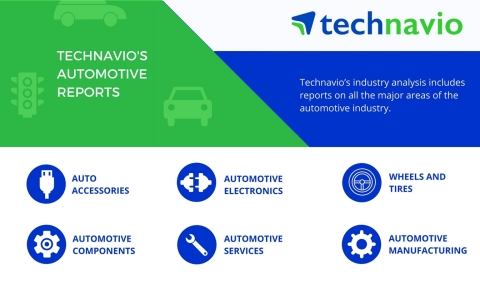Technavio’s latest market research report on the global automotive aftermarket for spark plugs provides an analysis of the most important trends expected to impact the market outlook from 2017-2021. Technavio defines an emerging trend as a factor that has the potential to significantly impact the market and contribute to its growth or decline.
This press release features multimedia. View the full release here: http://www.businesswire.com/news/home/20180109006675/en/

Technavio has published a new market research report on the global automotive aftermarket for spark plugs 2017-2021 under their automotive library. (Graphic: Business Wire)
One of the key factors resulting in the growth of the global automotive aftermarket for spark plugs is the declining sales of diesel cars leading to more market opportunity for gasoline cars. The Euro 6 norms have adversely affected the sales of diesel engines as the norms regarding diesel engines were made stringent. The decline in sales of diesel engines will lead to an increase in the market share for gasoline engine cars. This will drive the demand for the automotive aftermarket spark plugs.
This report is available at a USD 1,000 discount for a limited time only: View market snapshot before purchasing
Buy 1 Technavio report and get the second for 50% off. Buy 2 Technavio reports and get the third for free.
The three emerging market trends driving the global automotive aftermarket for spark plugs according to Technavio research analysts are:
- Growing preference for platinum and iridium spark plugs
- Better designed spark plugs for gasoline direct injection (GDI) engines
- Increasing demand for fuel-efficient cars
Looking for more information on this market? Request a free sample report
Technavio’s sample reports are free of charge and contain multiple sections of the report including the market size and forecast, drivers, challenges, trends, and more.
Growing preference for platinum and iridium spark plugs
There has been increasing preference for platinum and iridium spark plugs among OEMs. The demand has also been witnessed in the lower segment vehicles. Previously, platinum and iridium spark plugs were mainly used in the luxury segment. However, they are now being adopted in mass-selling vehicles too. Modern engines operate at high combustion temperatures causing greater electrode wear, which has resulted in the requirement of more resistant materials such as platinum, iridium, or rhodium.
According to Keerthi Balu, a lead analyst at Technavio forautomotive components, “Iridium spark plugs require low voltage. A precise spark delivered every time will result in efficient combustion, thereby increasing fuel economy. Bosch has extended its spark plug series with its double iridium spark plug, that has an average service life up to four times that of standard copper plugs.”
Better designed spark plugs for GDI engines
Modern GDI engines operate at higher pressure and temperature. The injection pressures in a GDI engine are usually between 100 and 120 bars in the combustion chamber, whereas the injection pressures can be as high as 250 bars in a turbo engine. Therefore, due to the higher working pressures, the requirement for ignition voltage also increases. As a result, spark plugs manufacturers are manufacturing high-performance spark plugs to withstand high pressure and temperature and ensure reliable ignition of the fuel-air mixture. Manufacturers are concentrating on developing spark plugs with greater mechanical and thermomechanical ruggedness to perform better in irregular combustion and to reduce electrode temperatures.
Increasing demand for fuel-efficient cars
The first standards for fuel economy were established by the US in 1970. Regions such as Japan, China, and many European countries established and moved forward in tightening their fuel economy standards by 2000. The major factors that contributed to the tightening of fuel economy standards were the threat of potential shortages of oil and the diverse climatic changes. Fuel economy standards were also aimed at improving energy efficiency of individual vehicles.
“The relative increase in the prices of oil has encouraged the customers to buy fuel-efficient vehicles. Thus, OEMs started concentrating on manufacturing fuel-efficient vehicles by reducing the size of the powertrain, reducing the weight of the vehicles and electrification of mechanical components,” says Keerthi.
Browse Related Reports:
- Global Automotive Roller Tappets Market 2017-2021
- Global Automotive Filters Market 2017-2021
- Global Commercial Vehicle Transfer Case Market 2017-2021
About Technavio
Technavio is a leading global technology research and advisory company. Their research and analysis focuses on emerging market trends and provides actionable insights to help businesses identify market opportunities and develop effective strategies to optimize their market positions.
With over 500 specialized analysts, Technavio’s report library consists of more than 10,000 reports and counting, covering 800 technologies, spanning 50 countries. Their client base consists of enterprises of all sizes, including more than 100 Fortune 500 companies. This growing client base relies on Technavio’s comprehensive coverage, extensive research, and actionable market insights to identify opportunities in existing and potential markets and assess their competitive positions within changing market scenarios.
If you are interested in more information, please contact our media team at media@technavio.com.
View source version on businesswire.com: http://www.businesswire.com/news/home/20180109006675/en/






















